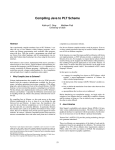Download The Fertility Calendar
Transcript
The Fertility Calendar Lelanthran Krishna Manickum August 4, 2011 1 Introduction Firstly, congratulations on your decision to have a child. Having and raising a child is one of the most rewarding activities many people experience during their lives, hence its continued popularity. Secondly, congratulations on choosing Conception to help ensure that you conceive your baby in the fastest time possible. Conception is designed to require very little work on your part to determine the days of the month that are statistically best suited to making a baby, and of course, those days that are better for making a boy baby and those days that are better for making a girl baby. As every woman is an individually unique specimen of the fairer sex, it is sometimes necessary to fine-tune the workings of Conception in order to more accurately predict the fertile period of the cycle. In this document I will hold your hand through some of the more complicated parts of the process so that you get the most accurate predictions from Conception, and I leave the more natural parts of the process (you presumably know what these are) to yourself and your partner. If your cycle follows the average in every way, you will not need to fine-tune Conception at all. In fact, it might be best to leave Conception as it is initially when you start using it, as Conception has some basic learning capabilities built in, and will make an effort to learn your rhythm as each cycle passes by. Of course, it is also possible to turn off the learning abilities of Conception if you ever feel that it is a bad learner. While every effort is made to be as accurate as possible, please note that in the field of statistics, an event being highly improbable does not imply that it won’t happen at all; it just means that there is a smaller chance of it happening. So, when I say “the odds of conceiving a female is lower than conceiving a male”, I mean just that — the odds are only lower; you might just beat the odds and get a female. Also, when I say that you have a high chance of, for example, getting pregnant, this does not automatically mean that you will get pregnant, it simply means that the odds are good that you will conceive. Figure 1: Conception starting for the first time Finally, there is the matter of the legal disclaimer. I did not initially want to put any legalese into this document, but the attack-shark who doubles as my lawyer has assured me that the world might in fact end if a product is released without a lawyer getting paid to write the legal disclaimer. 1 This product has only been tested on Android Platforms version 2.2 or higher. This product does not come with any guarantees of merchantability or fitment for any purpose, neither express nor implied. Consult a doctor for medical advice. While this program does not come with any promises or guarantees, it does come with my heartfelt hope that it will work for you, and that you find it useful. Of course I would love to hear anything you have to say about this product, the good and the bad. If you have successes, please by all means let me know; I get a great deal of satisfaction from knowing that I helped someone. If you have any failures, be sure to let me know of these as well, as it would highlight shortcomings of Conception that might be fixable in the future. 2 How Conception will work with you Conception was designed to be as easy to use as possible. It runs in the background of your Android device, and has been designed to use almost negligible power. Each month when your period starts you inform Conception of the date of your period, and then it calculates the fertile days for the rest of the month, and displays those days in particular shaded colours on the calendar (RED shades indicate a higher chance of conceiving a girl, BLUE shades indicate a higher chance of conceiving a boy). Some other dates on the calendar are also highlighted – see Figure 2. After you quit the application, Conception maintains its calculations and updates your status bar at the top of the screen with a little icon that provides information on your fertile times (See Figure 2 that displays where the notification icon is placed). This update is done a little after midnight each day. Figure 2: All the elements of the application. Once you have set the start date of your cycle (the very first day of your period), you will not need to start the application again until the start of your next cycle. In the 26-30 days between the period start dates, you can always see what your current fertility status is by simply looking at the notification bar. Figure 3 shows each possible icon that can be displayed in the notification bar together with the meaning. If you feel that this is too public a place to display your status, you can turn this this ability off so that others who simply glance at your phone won’t automatically see your private information. In other words, if you are in a fertile period, you may not want to display this fact on the home screen of your phone; Conception will happily let you turn this display off. Turning this display off will 2 not affect the calculations that are done, and you are always free to turn it back on later. You can turn notifications on and off from the Conception menu. Fertile, high chance of male Fertile, high chance of female Fertile, equal chance of male or female Not fertile An error has occurred Figure 3: The various notification icons. Whenever you start Conception it will always display a calendar with the current date highlighted with a white border, the calculated date of your next period highlighted in YELLOW , and your fertile days highlighted in shades starting with RED and gradually fading into BLUE . The more RED in the shade indicates a higher chance of conceiving a girl, if conception occurs at all, while the more BLUE in the shade indicates a higher chance of a boy, if conception occurs at all. This is all you actually need to know to use Conception, I suggest you try using Conception for at least four cycles before you attempt to fine-tune it for accuracy. In other words, for the first four cycles it might be best to simply stick to selecting “Period Start Today” or “Period Already Started” from the Menu and let Conception try to figure out what the best values would be for you. If you have already tried that, or if you already know that your cycle is not of the usual 28-day length, then you should go through the next section and try changing some of the options that would apply to you or your partner. 3 3.1 Conception Options How to change an option value Changing the values that Conception uses to track your fertile periods can, if done incorrectly, break Conception in subtle ways. If this ever happens, Conception can be restored to its factory-default settings by either: • Selecting “Reset” from the Conception Menu. • Clearing all the stored data from the Android System Menu. 3 Now that you know how to restore the program if it ever stops working, lets plunge headlong into the options. First, to bring up the options that can be changed, select “Options” from the Menu. What will be displayed would be a list of option by name, with each of the options current values on the right, such as shown in Figure 4. You can change the value for each of the options (within certain ranges). Conception is of the opinion that The Customer Is Always Right, and so if you change a value to something that does not make sense, for example making Conception think that your partners sperm cells will live for a hundred years, then Conception will happily let you do that. This is why you should always take care before changing any value. If you give Conception incorrect information, it will believe you, and as a result give you incorrect results. In short, if you lie to Conception, it will happily lie right back at you. Note that I might not explain all of the options that you may see on the options screen. This is not because I’m a dastardly crook trying to prevent you using Conception to the fullest, but merely because some of them are too difficult to change right now without further consultation with a doctor. I leave them in, in the hope that a future document will better explain how to make those changes. Figure 4: The options screen. After you have changed all the values you want to change, simply press “Apply” to save your changes. If you change your mind and don’t want to save the changes you’ve just made, then instead press “Cancel”. Once you press “Apply”, there is no way to restore the previous value. You can always reset Conception to the factory settings as described above or simply just enter a new value for that particular option. 3.2 Sperm Life Span - spermLifeSpan Sperm cells have a limited life-span after leaving the mans body. In the womans body they may survive for between three and five days. The default is four. The longer they survive, the longer the fertility period is. For example, if they survive for four days, then Conception will calculate a fertile period of around 6 days. When changing this, you need to take into account your partners lifestyle. Use the following as a guide when changing this from the default of four days: 4 • Does your partner smoke or drink daily? Subtract 1 day (subtract daily, or only smokes daily, but not both). 1 2 a day if he either only drinks • Does your partner exercise (cardiovascular) on a regular basis? Add 1 day. • Does your partner exercise excessively on a cycling machine or a bicycle? Subtract 1 day. • Does your partner eat unhealthily? Subtract 1 2 a day. • Is your partner currently in a time of high stress? Subtract • Is your partner diabetic? Subtract 1 2 1 2 a day. a day. • Does your partner sleep for more than 8 hours every night? Add 1 day. You should consult your doctor to get a more accurate idea of how healthy your partners sperm can be. The above is a rough guideline to help you get an idea of the lifespan of your partners sperm cells. Note that there are many more factors that can affect the lifespan of sperm cells. 3.3 Luteal Phase - lutealPhase The luteal phase of your cycle (together with the length of your cycle) is used by Conception to calculate the day of ovulation. This is usually 14 days in most women, but you can always measure your cycle in one of the two ways described below, and change the value used by Conception if you find that your luteal phase is not 14 days. To measure the length of your luteal phase using temperature, you need to purchase a Basal Thermometre, available at most pharmacies, and you need to record your temperature every day for one entire cycle, starting on the first day of your period. Ensure that the temperature is always taken every day at the same time and under the same circumstance. It might just be easier to record the temperature the very instant you wake up, before even getting out of bed. The luteal phase starts towards the middle of your cycle, and is identified by a slightly higher body temperature, and ends at the first day of your next period. After you’ve recorded your temperature identify the day that your temperature was slightly higher than usual, and count the number of days from that day (including the day the temperature was slightly higher) to the start of the next period. This number is the length of your luteal phase. Its best to produce a chart of your temperature so that you can clearly see the day that it rises. See Figure 5 for an example of a chart produced by measuring the temperature every day. 5 The second method of determining the length of your luteal phase is by using a urine-based ovulation test (which is also available at most pharmacies). This works similar to a home pregnancy test kit, and all you do is simply count the days from when the ovulation test is positive to the start of your next period. Figure 5: A chart showing the temperature increase that indicate ovulation on day 12 of this womans monthly cycle. 3.4 Average Cycle Length - avgLength Conception uses the average length of all your cycles in its calculations. Obviously, if this is incorrect – for example it will start off using an average of 28 days – you will want to rectify it. For example, if you missed a period due to ill-health or similar, then you don’t want Conception averaging your periods with a 60-day cycle. You can change this to what your average really is. While Conception does try to learn your rhythm, it is recommended that you change this value if it is incorrect. If you would prefer Conception to use a fixed length as your period length and not use any of the averages it calculates, then change the option fixedLength. 3.5 Constant Cycle Length - fixedLength Set this value only if you would prefer Conception to ignore the average cycle length; if this is any positive value, Conception will use this value as the length of your cycle instead of using the average it calculates. If you change your mind later and you want Conception to use the average again, simply set this value to -1, and Conception will use the average instead. 6 A word to the wise: A study found that the majority of women who were asked how long their cycle was were found to be incorrect when their cycle was actually measured. Even if you think that your cycle is usually (for example) 26 days, please measure it before changing the behaviour in Conception. 4 Further contact If you’d like to contact me, please by all means do so. Conception has an item called “About” in the menu that will point you to a website with all the details about Conception, as well as contact information. I welcome feedback and criticism. 5 Acknowledgments Nothing of value is ever created by the efforts of a single person. I thank the following people for their part in the creation of Conception and the various associated documents, and wish to draw attention to the fact that none of the people below are actually responsible for any errors that you may find. All errors are mine and mine alone. • Mr and Mrs Singh and their daughter Kaira and son Raiden, who allowed me to use pictures of my niece and my nephew in this document. • Onkgepotse Molefe, who performed the Tswana translation of Conception. • Mixo Shiburi, who was (and still is) a useful sounding-board for ideas, and who frequently donated valuable contributions to this effort in the shape of criticism. • Dr Alisha Chunder, who originally inspired me to develop the initial prototype of Conception, and who subsequently provided insightful feedback regarding the user-interface and utility of Conception. 7





















